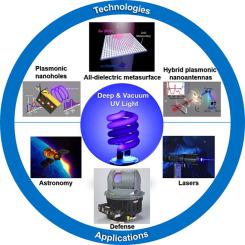当前位置:
X-MOL 学术
›
Mater. Today
›
论文详情
Our official English website, www.x-mol.net, welcomes your
feedback! (Note: you will need to create a separate account there.)
Deep- and vacuum-ultraviolet metaphotonic light sources
Materials Today ( IF 21.1 ) Pub Date : 2021-06-23 , DOI: 10.1016/j.mattod.2021.05.019 Arash Ahmadivand , Burak Gerislioglu
Materials Today ( IF 21.1 ) Pub Date : 2021-06-23 , DOI: 10.1016/j.mattod.2021.05.019 Arash Ahmadivand , Burak Gerislioglu

|
Recent demonstrations of deep- and vacuum-ultraviolet (DUV and VUV) light emission from artificially engineered meta-atoms through nonlinear harmonic signal generation processes have opened up new avenues for fundamental engineering approaches and modern applications. While many different phenomena based on optical metasurfaces have been revealed in linear optics, several studies have reported the observation of various nonlinear optical phenomena in such nanosystems, like, for example, second and third harmonic generation (SHG and THG), multiphoton luminescence, higher harmonic generation, and four-wave mixing. Plasmonic and all-dielectric flatland metasurfaces enable successful manipulation of light–matter interactions on ultradense platforms and provide substantial enhancement of driving fields, which make these architectures promising and attractive to efficiently radiate intense and coherent second and third harmonic radiations. In this focused Review, we highlight and discuss the recent state-of-the-art methods that have been developed and proposed for the generation of nonlinear harmonic signal and high-energy DUV and VUV lights. This contribution not only summarizes the strategies that have been exploited for augmenting the intensity of nonlinear UV signal, but also introduces the novel mechanisms to strongly optimize the conversion efficiency of this principle. We envisage that this understanding allows to compare the performance of versatile nonlinear DUV and VUV metasources and paves the way of designing much more efficient light emitting tools such as lasers, super-resolution imaging nanosystems, and nanolithography apertures.
中文翻译:

深紫外和真空紫外变光子光源
最近通过非线性谐波信号生成过程从人工设计的元原子发射深紫外和真空紫外(DUV 和 VUV)光的演示为基础工程方法和现代应用开辟了新途径。虽然线性光学中已经揭示了许多基于光学超表面的不同现象,但一些研究报告了在此类纳米系统中观察到的各种非线性光学现象,例如二次和三次谐波产生(SHG和THG)、多光子发光、更高谐波产生和四波混频。等离激元和全介电平面超表面能够成功操纵超密平台上的光与物质相互作用,并显着增强驱动场,这使得这些结构在有效辐射强烈且相干的二次和三次谐波辐射方面具有前景和吸引力。在这篇重点综述中,我们重点介绍并讨论了最近开发和提出的用于生成非线性谐波信号和高能 DUV 和 VUV 光的最先进方法。该贡献不仅总结了用于增强非线性紫外信号强度的策略,而且还引入了新的机制来大力优化该原理的转换效率。我们设想,这种理解可以比较通用非线性 DUV 和 VUV 元源的性能,并为设计更高效的发光工具(如激光器、超分辨率成像纳米系统和纳米光刻孔径)铺平道路。
更新日期:2021-06-23
中文翻译:

深紫外和真空紫外变光子光源
最近通过非线性谐波信号生成过程从人工设计的元原子发射深紫外和真空紫外(DUV 和 VUV)光的演示为基础工程方法和现代应用开辟了新途径。虽然线性光学中已经揭示了许多基于光学超表面的不同现象,但一些研究报告了在此类纳米系统中观察到的各种非线性光学现象,例如二次和三次谐波产生(SHG和THG)、多光子发光、更高谐波产生和四波混频。等离激元和全介电平面超表面能够成功操纵超密平台上的光与物质相互作用,并显着增强驱动场,这使得这些结构在有效辐射强烈且相干的二次和三次谐波辐射方面具有前景和吸引力。在这篇重点综述中,我们重点介绍并讨论了最近开发和提出的用于生成非线性谐波信号和高能 DUV 和 VUV 光的最先进方法。该贡献不仅总结了用于增强非线性紫外信号强度的策略,而且还引入了新的机制来大力优化该原理的转换效率。我们设想,这种理解可以比较通用非线性 DUV 和 VUV 元源的性能,并为设计更高效的发光工具(如激光器、超分辨率成像纳米系统和纳米光刻孔径)铺平道路。











































 京公网安备 11010802027423号
京公网安备 11010802027423号